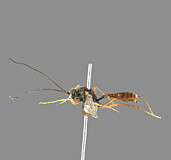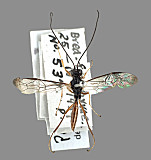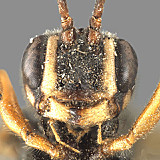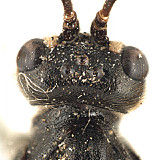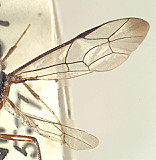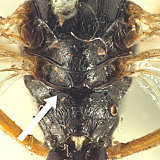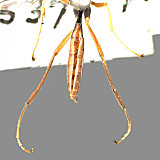Pergaphaga leaski Wharton, 2010
The species is named for Maurice Leask, who reared numerous westwoodiines from various pergid sawflies, including all of the members of the type series. This species is referred to as Pergaphaga sp. 1 in Gauld (1984).
As in the larger-bodied Pergaphaga iangauldi Cammack and Wharton, an elevated median flange is absent on the frons (Figs 3, 4). An elevated, interantennal flange extending posteriorly onto the frons is present in the other two species of Pergaphaga, P. nigra and P. xanthops Wharton. The shared loss of the elevated flange is the most distinctive feature supporting the sister-group relationship between P. iangauldi and P. leaski. In addition to differences in antennal color pattern (bicolored in P. iangauldi) , P. iangauldi has a more heavily sculptured mesopleuron than P. leaski.
Pergaphaga iangauldi, P. leaski, and P. xanthops form a well-supported clade relative to P. nigra, characterized by reduced body sculpture (Fig. 6), reduced fore wing areolet (Fig. 2), and the pattern of pale coloration on the face (Fig. 3), legs (Fig. 7), and metasoma (Figs 1, 7).
The mesopleural depression is more sparsely punctate ventrally in P. leaski than in both P. nigra and P. iangauldi, with the punctures widely separated, not coalescing medially to form either strigose or rugulose sculpture. The rounded lobe forming anterodorsal margin of mesopleural depression has similarly large, well-spaced punctures.
Type material. Holotype. Female (BMNH), with handwritten labels as follows: “Bred. from. larvae./ 25-iv-1959/ No. 537. P.” “Australia./ Victoria./ Ballarat./ M.F. Leask.” “Glen. Park. S.F./ at. Wayne’s./ Sawfly/larvae.” “adult.recog. Leask./ pergagrapta ♂/gravenhorstii/ Westwood.1880” “Pergaphaga/ det. I.D. Gauld, 1984” [partially printed] “HOLOTYPE/ Pergaphaga/ leaski/ Wharton” [red, handwritten]
Paratypes: 2 females, same data as holotype (BMNH); 1 female, 1 male, same data except 1.vii.1959 and without Glen Park label.
All paratypes have an additional British Museum 1959-460 accession label.
This work would not have been possible without the groundwork provided by Ian Gauld’s study of the Australian Westwoodiini, and we are particularly grateful for his assistance in many aspects of this study, including the initial recognition of P. leaski as an undescribed species. We also thank the following curators and researchers for extended loans of the material used for this revision: John LaSalle (ANIC), Ian Gauld (deceased) and Gavin Broad (BMNH), Ken Walker (MVMA), and Chris Burwell (QMBA). We thank David Wahl of the American Entomological Institute (AEIC) for permission to use material previously published in the Contributions of the American Entomological Institute, as well as for useful feedback throughout our study of Westwoodiini. Matt Yoder provided considerable assistance with databasing issues, and our use of PURLs (http://purl.oclc.org) in this regard follows the example of their use in publications by Norm Johnson. Heather Cummins also graciously assisted us with image processing, formatting, and literature retrieval. This revision was conducted at Texas A&M University and is based upon work supported by the National Science Foundation’s PEET program under Grant No. DEB 0328922 and associated REU supplement nos DEB 0723663 and DEB 0522836. Page last updated November 2010.
This material is based upon work supported by the National Science Foundation under Grant Number DEB 0328922 with REU supplement DEB 0723663 and DEB 0522836.
Any opinions, findings, and conclusions or recommendations expressed in this material are those of the author(s) and do not necessarily reflect the views of the National Science Foundation.

